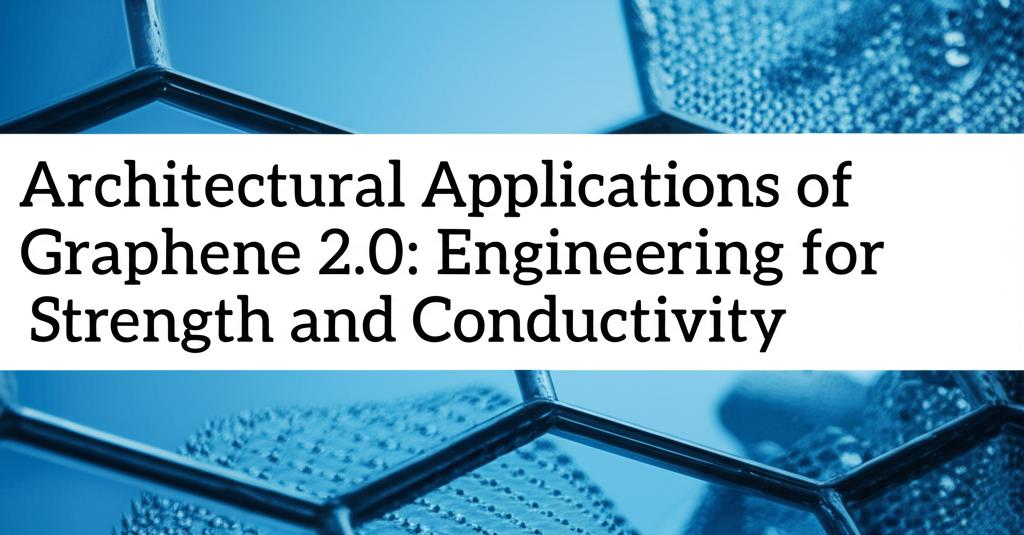Graphene, a single layer of carbon atoms arranged in a hexagonal lattice, continues to be a game-changer in materials science, and its advanced forms, often dubbed "Graphene 2.0," are unlocking new potentials in architecture. These next-generation graphene materials and composites are specifically engineered to offer enhanced strength and superior electrical conductivity, paving the way for innovative and sustainable building solutions.
Enhanced Strength for Resilient Structures
The remarkable mechanical strength of graphene is a key attribute being leveraged in construction. When incorporated into building materials, even in small quantities, graphene can significantly boost their performance.
- Stronger Concrete: Graphene-enhanced concrete, often referred to as "Concretene," demonstrates substantial improvements in strength – some studies show it to be up to 2.5 times stronger than traditional concrete. This increased strength means that structures can be built using less material, potentially reducing cement requirements and, consequently, CO2 emissions associated with cement production by as much as 30%. Engineers at The University of Manchester's Graphene Engineering Innovation Centre (GEIC) have been at the forefront of developing Concretene, showcasing its potential to increase the service life of concrete and improve durability.
- Lighter and More Durable Materials: By increasing tensile strength, graphene allows for the creation of lighter building components without compromising structural integrity. This is particularly beneficial for elements like facades and roofing. The enhanced durability also translates to longer lifespans for structures and reduced maintenance needs.
- Improved Resistance: Graphene's impermeability and corrosion resistance offer significant advantages. Graphene-enhanced materials are less susceptible to water penetration, which can mitigate issues like corrosion of steel reinforcements and freeze-thaw damage in concrete. This leads to more resilient and longer-lasting buildings. Some reports indicate graphene-enhanced concrete is four times less water permeable than standard concrete.
- Flexibility and Hardness: The addition of graphene can improve the flexibility and hardness of various building materials, making them more adaptable to different architectural designs and more resistant to wear and tear.
Superior Conductivity for Smart and Efficient Buildings
Graphene's exceptional electrical and thermal conductivity is opening doors to a new era of smart and energy-efficient buildings.
- Smart Infrastructure: The ability of graphene to conduct electricity allows for the development of "smart concrete" and other intelligent building materials. Embedded graphene-based sensors can monitor the structural health of buildings in real-time, detecting stress, deformations, temperature, and humidity. This can provide early warning signals for potential structural failures, enhancing safety and allowing for timely maintenance.
- Energy Efficiency: Graphene's thermal conductivity can be utilized to improve energy efficiency. Graphene-infused coatings and additives can enhance thermal insulation, reducing heating and cooling demands. Innovations like self-heating walls and de-icing systems for roads and building surfaces are being explored.
- Spray-On Solar Panels: The optical transparency and high conductivity of graphene make it a valuable material for advancing solar technology. Incorporating graphene into spray-on solar panels has the potential to significantly increase energy conversion efficiency compared to traditional panels. These lightweight and flexible panels could simplify solar power adoption.
- Conductive Inks and Electronics: Graphene's conductivity is also being harnessed in conductive inks, which can be used for printing electronic circuits directly onto building surfaces. This can lead to integrated lighting, heating elements, and other electronic functionalities seamlessly incorporated into the architectural design.
Advancements and Future Outlook
Research and development in graphene applications for architecture are rapidly advancing.
- Cost-Effective Production: Efforts are underway to develop more cost-effective methods for producing high-quality graphene, which is crucial for its widespread adoption in the construction industry. Novel strategies include in-situ growth of graphene within cement matrices using low-cost carbon sources.
- Graphene-Based Composites: The development of graphene-based composites with other materials like polymers is leading to new materials with tailored properties for specific architectural needs. These composites can offer a combination of strength, lightness, and conductivity.
- 3D Printing: Graphene-enhanced materials are showing great potential in 3D printing for construction, allowing for the creation of complex and customized building components with superior properties.
- Sustainability: The push for more sustainable construction practices is a major driver for graphene research. By reducing material usage, enhancing durability, and improving energy efficiency, graphene contributes to a more environmentally friendly built environment. Projects like GIANCE are focused on developing the next generation of cost-effective, sustainable, and recyclable graphene-based multifunctional composites.
While the integration of graphene into mainstream construction is still evolving, its engineered forms for enhanced strength and conductivity are demonstrating transformative potential. As research continues and production methods become more scalable and economical, Graphene 2.0 is poised to play an increasingly significant role in creating stronger, smarter, and more sustainable architectural solutions for the future.

